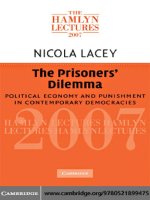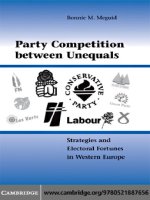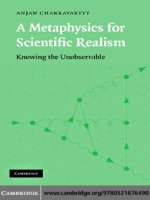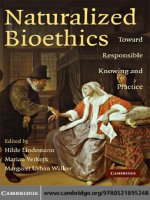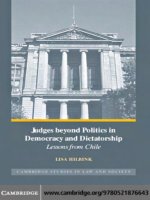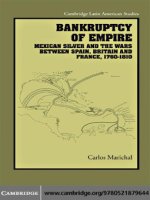0521842603 cambridge university press hume dialogues concerning natural religion and other writings may 2007
Bạn đang xem bản rút gọn của tài liệu. Xem và tải ngay bản đầy đủ của tài liệu tại đây (1.29 MB, 216 trang )
This page intentionally left blank
CAMBRIDGE TEXTS IN THE
HISTORY OF PHILOSOPHY
HUME
Dialogues concerning Natural Religion
CAMBRIDGE TEXTS IN THE
HISTORY OF PHILOSOPHY
Series editors
KARL AMERIKS
Professor of Philosophy, University of Notre Dame
DESMOND M. CLARKE
Professor of Philosophy, University College Cork
The main objective of Cambridge Texts in the History of Philosophy is to expand the range,
variety, and quality of texts in the history of philosophy which are available in English.
The series includes texts by familiar names (such as Descartes and Kant) and also by lesswell-known authors. Wherever possible, texts are published in complete and unabridged
form, and translations are specially commissioned for the series. Each volume contains a
critical introduction together with a guide to further reading and any necessary glossaries
and textual apparatus. The volumes are designed for student use at undergraduate and
postgraduate level and will be of interest not only to students of philosophy, but also to a
wider audience of readers in the history of science, the history of theology, and the history
of ideas.
For a list of titles published in the series, please see end of book.
DAVID HUME
Dialogues concerning
Natural Religion
and Other Writings
EDITED BY
DOROTHY COLEMAN
Northern Illinois University
CAMBRIDGE UNIVERSITY PRESS
Cambridge, New York, Melbourne, Madrid, Cape Town, Singapore, São Paulo
Cambridge University Press
The Edinburgh Building, Cambridge CB2 8RU, UK
Published in the United States of America by Cambridge University Press, New York
www.cambridge.org
Information on this title: www.cambridge.org/9780521842600
© Cambridge University Press 2007
This publication is in copyright. Subject to statutory exception and to the provision of
relevant collective licensing agreements, no reproduction of any part may take place
without the written permission of Cambridge University Press.
First published in print format 2007
eBook (NetLibrary)
ISBN-13 978-0-511-27936-2
ISBN-10 0-511-27936-1
eBook (NetLibrary)
ISBN-13
ISBN-10
hardback
978-0-521-84260-0
hardback
0-521-84260-3
ISBN-13
ISBN-10
paperback
978-0-521-60359-1
paperback
0-521-60359-5
Cambridge University Press has no responsibility for the persistence or accuracy of urls
for external or third-party internet websites referred to in this publication, and does not
guarantee that any content on such websites is, or will remain, accurate or appropriate.
For my daughter, Alexandra
Contents
page ix
xi
xli
xliv
xlix
liii
Acknowledgments
Introduction
Chronology
Further reading
Note on the text
List of abbreviations
Pamphilus to Hermippus
Part
Part
Part
Part
Part
Part
Part
Part
Part
Part
vii
Contents
Part
Part
From Hume’s memoranda
Fragment on evil
Letter to Francis Hutcheson, March , (extract)
Letter to William Mure, June , (extract)
Letters to Gilbert Elliot (extracts)
From The Natural History of Religion
Selections from Pierre Bayle (translated by James Dye)
Index
viii
Acknowledgments
For both critical and encouraging comments on my Introduction and
editorial notes I am indebted to James King, David Raynor, M. A. Stewart,
and John Wright. Thanks also to David Raynor for drawing my attention
to Edward Gibbon’s remark on Hume’s Dialogues, and to J. V. Price for
pointing out to me that Matthew Prior is the source for “Not satisfied with
life, afraid of death” in Part of the Dialogues. I also thank the Hume
Society for accepting my paper, “Hume’s Philosophy of Ridicule,” for its
th Hume Conference in Helsinki, August, , where the discussion
helped direct my approach to the Introduction. I am grateful to Desmond
Clarke and Hilary Gaskin for inviting me to undertake this project and
for their helpful editorial advice. I owe special thanks to James Dye for
preparing the translations of Bayle that are part of the supplementary
readings for this volume. Not least, I am grateful to my late afternoon tea
companions, Andrea Bonnickson, Annette Johns, and Sharon Sytsma,
for their friendship and support throughout this project.
ix
Introduction
David Hume’s Dialogues concerning Natural Religion () is one of the
most influential works in the philosophy of religion and the most artful
instance of philosophical dialogue since the dialogues of Plato. Some
consider it a successful criticism of rational theology, some find it a failure,
others regard it as a defense of some form of natural religion, and yet
others emphasize its influence on the development of fideism, religious
belief that disclaims rational justification. The great eighteenth-century
historian, Edward Gibbon, said that of all Hume’s philosophical works
it is “the most profound, the most ingenious, and the best written.” All
readers, regardless of their final assessments, can appreciate its penetrating
analyses as well as its entertaining wit and ironic humor.
The topic of the Dialogues is natural religion, that is, religious belief,
sentiment, and practice founded on evidence that is independent of supernatural revelation. The work presents a fictional conversation among three
friends – Cleanthes, Philo, and Demea – that is overheard and later narrated by Pamphilus, Cleanthes’ pupil, to his friend Hermippus. Although
the names of the characters come from antiquity, the temporal setting
Translated from M. Baridon, “Une lettre in´edite d’Edward Gibbon a` Jean-Baptiste Antoine
Suard,” Etudes anglaises (), : “[J]e ne crains pas de prononcer que de tous les ouvrages
Philosophiques de M. H. celui-ci [the Dialogues] est le plus profond, le plus ingenieux et le mieux
e´ crit.”
Hume probably named Philo after Philo of Larissa, Cicero’s teacher. He probably named Cleanthes
after the second head of the school of Stoicism, Cleanthes of Assos (c. –c. ), a religious
enthusiast. The names of the other characters may also have eponymous sources, but their etymological significance is more obvious. “Demea,” from the Greek demos, meaning “people,” is an
appropriate name for one who defends popular or traditional religion. “Pamphilus,” from the Greek
pan (all) and philos (friend), meaning “friend of all,” is appropriate for a Shaftesburean narrator
who states that “opposite sentiments, even without any decision, afford an agreeable amusement.”
xi
Introduction
is an eighteenth-century one, and the main characters represent philosophical or religious types. They all profess, for different reasons, that the
existence of God is evident; but Philo, a skeptic, and Demea, an orthodox
theist, urge that the nature of God is incomprehensible, while Cleanthes,
an empirical theist, dismisses their skepticism as excessive. He proposes
an argument based on the systematic order in nature – commonly known
as the argument from design – to establish both the existence of God and
his possession of human-like intelligence. Cleanthes later adds that the
beneficial aspects of nature’s order provide compelling evidence of God’s
moral perfection, which, if left doubtful or uncertain, would spell “an end
at once of all religion” (.).
Hume has Philo present a series of powerful criticisms of Cleanthes’
argument up to the final section of the dialogue, where he endorses a qualified inference to an intelligent cause of nature that stops short of attributing moral qualities to it. Although Philo dominates the conversation and
is standardly taken to represent Hume’s views, Hume makes Cleanthes
the putative apparent hero of the piece (LE, ), and has Pamphilus
pronounce at the end that “upon a serious review of the whole, I cannot
but think, that Philo’s principles are more probable than Demea’s; but
that those of Cleanthes approach still nearer to the truth” (.). This
conclusion is dramatically foreshadowed in characterizations attributed
to Hermippus in the Dialogues’ prologue that contrast the “rigid, inflexible orthodoxy of Demea,” the “careless scepticism of Philo” and the
“accurate philosophical turn of Cleanthes” (Prologue, ).
The most controversial problem in interpreting Hume’s Dialogues is
what to make of Philo’s acceptance of the design argument in Part ,
the concluding section of the work. Many readers find it difficult to reconcile his previous criticisms of the argument with his final confession
that “no one has a deeper sense of religion impressed on his mind, or
pays more profound adoration to the divine being, as he discovers himself
to reason, in the inexplicable contrivance and artifice of nature” (.).
In one sense the puzzle is about whether Philo is consistent. In another
sense the puzzle is about whether Hume is consistent or whether Philo
consistently represents Hume’s own beliefs. This introduction will suggest a solution to this and other puzzles in the course of elucidating the
“Hermippus,” from the Greek herma (stone boundary markers topped with a bust of Hermes) is
an appropriate name for one who contrasts the characters of the three conversationalists.
xii
Introduction
Dialogues’ argumentative structure, its relation to Hume’s other writings,
and its broader historical context.
Natural religion, philosophical dialogue, and skepticism
A variety of religious and moral interests motivated the preoccupation
with natural religion during Hume’s time. The perceived enemies of
religion were the ancient Greek atomist, Epicurus, and two seventeenthcentury philosophers, Baruch Spinoza and Thomas Hobbes. Epicurus
maintained that the order of the universe arose from chance and that the
gods have no interest in human affairs. Hobbes argued that all occurrences
in nature, including human thoughts and volitions, are reducible to the
motions of matter governed by general laws. He also denied that the
attributes of God could be known. Spinoza argued that God and nature
are the same and that God’s actions are logically necessary consequences
of his nature, not free actions involving deliberation and choice. Although
some theists accepted certain aspects of these theories, most considered
them practically equivalent to atheism because a God who takes no interest
in the world or human affairs, whose nature is unknowable, or whose
actions are mediated through or identical with physical processes that
occur by chance or necessity but not by choice, does not appear to be a
God who can evoke religious sentiments of reverence and worship.
With the exception of extreme fideists, most theists considered natural religion a useful tool for answering doubts regarding theism posed
by these philosophical systems. Moderate theists, such as Latitudinarians, also invoked natural religion to defend tolerance of opposing sects
whose main doctrines could be justified by natural religion. On the other
hand, deists attacked all forms of revealed religion, believing that true
religion begins and ends with natural religion. Many theists also appealed
to natural religion either to justify moral obligation or strengthen moral
For example, the subtitle of Samuel Clarke’s Demonstration of the Being and Attributes of God is More
particularly in answer to Mr. Hobbes, Spinoza, and their followers, and Clarke targets the Epicurean
doctrine of chance in the same work. See Clarke, A Demonstration of the Being and Attributes of God
and Other Writings, ed. Ezio Vailati (Cambridge and Yew York: Cambridge University Press, ),
pp. ; , . Berkeley specifies that his philosophy opposes those who take refuge in “the doctrines
of an eternal succession of unthinking causes and effects, or in a fortuitous concourse of atoms;
those wild imaginations of Vanini, Hobbes, and Spinoza; in a word the whole system of atheism,”
Three Dialogues between Hylas and Philonous, in Works, ed. T. E. Jessop and A. A. Luce (London
and New York: T. Nelson, –), :. He also targets Epicurus, Hobbes, and Spinoza in his
Alciphron, Fourth Dialogue, Sec. , in Works, :.
xiii
Introduction
motivation. Even free-thinking philosophers, such as Shaftesbury and
Francis Hutcheson, who claimed that atheists are as capable of virtue
as theists, contended that belief in divine rewards and punishments in
an afterlife is morally preferable to atheism because it reinforces virtuous
motives when they are opposed by a sense of the apparent futility of virtue
and evident advantages of vice. Most of Hume’s contemporaries, then,
would have considered his criticism of natural religion offensive to both
religion and morality.
This offensiveness explains why the Dialogues, although first drafted in
, was not published until , three years after Hume’s death. Hume
wanted to publish the work during his lifetime, but his friends discouraged him from doing so because they feared it would raise new charges of
atheism, skepticism, and immoralism against him. Although Hume had
never denied the existence of God or an ultimate cause of nature and had
never explicitly questioned the validity of the design argument prior to
the Dialogues, many of his critics believed that the basic principles of his
philosophy as laid out in his Treatise of Human Nature (–), Enquiry
concerning Human Understanding (), and Enquiry concerning the Principles of Morals () undermined morality and religion. As a result, he
was twice passed over for academic appointments and an effort was made
to excommunicate him from the Church of Scotland. Although mindful
of his friends’ concerns, Hume believed that “nothing can be more cautiously or artfully written” than his Dialogues (LDH :). Encouraged
by those who considered it his best work, Hume made provisions in his
will for his nephew to publish it within three years of his death, reasoning
that no one could fault a nephew for dutifully carrying out his uncle’s last
wishes.
Caution probably led Hume to cast his criticism of natural religion in
the form of a dialogue so that he could avoid speaking in his own voice,
but this was only one of several motives. Among them was his intention to
correct, by example, the prejudicial manner in which modern dialogues
on religion tended to represent the character of skeptics.
Anthony Ashley Cooper, Third Earl of Shaftesbury, “An Inquiry Concerning Virtue or Merit,” in
Characteristics of Men, Manners, Opinions, Times, ed. Lawrence E. Klein (Cambridge: Cambridge
University Press, ), –; Francis Hutcheson, An Essay on the Nature and Conduct of
the Passions and Affections, with Illustrations on the Moral Sense, rd edn. (facs. rpt., Gainesville:
Scholars’ Facsimiles & Reprints, ), .iv.
xiv
Introduction
The opening sentence of the Dialogues’ prologue alludes to Shaftesbury’s call in the early part of the century for a revival of Socratic dialoguewriting that pursues pedagogical ends through unrestrained, reasoned
debate. Shaftesbury lamented that modern philosophical dialoguewriting had devolved into the hands of dogmatic clerics who criticized
heterodox opinions through misrepresentation, false ridicule, and allegations of immoralism. These writers apparently feared that representing arguments against orthodoxy in a favorable light would give them
an undeserved public influence dangerous to the interests of true religion. Shaftesbury defended tolerant inquiry on methodological grounds.
He urged that dialogue-writers must address opposing opinions through
accurate representations and logical rebuttal to assure that inquiry does
not perpetuate errors. Still, Shaftesbury did not rule out the use of raillery
and ridicule altogether. Believing that wit and humor are natural and pleasurable components of free-spirited conversation, he defended a polite
form of raillery in dialogue-writing such as that used in private conversation among sensible friends whose moral virtues are never in question
despite their minor flaws. He also defended what he called “defensive
raillery,” the use of irony when “the spirit of curiosity would force a
discovery of more truth than can conveniently be told.”
Similarly, Hume emphasized the importance of avoiding the “vulgar
error” in dialogue-writing that puts “nothing but nonsense into the mouth
of the adversary” (LE, ). He has his conversationalists engage in
See Shaftesbury, “Soliloquy, or Advice to An Author,” “The Moralists,” and “Miscellany V” in
Characteristics, –, –, and –. Hume owned a copy of the edition of the
Characteristics, which he signed and dated in when he was fifteen. Shaftesbury’s philosophical
views about dialogue and soliloquy may have inspired the young Hume’s decision to compose
a manuscript, completed before he was twenty, that recorded the progress of his thoughts on
religion. Hume recounted that the manuscript began with an “anxious search after arguments to
confirm the common opinion” of God’s existence. Then “doubts stole in, dissipated, returned,
were again dissipated, returned again; and it was a perpetual struggle of a restless imagination
against inclination, perhaps against reason.” He burned the manuscript not long before sending
the sample of his Dialogues to Gilbert Elliot in . See LE, .
Critics of orthodoxy were also commonly guilty of abusive ridicule and misrepresentation. In their
defense, they maintained that treating orthodoxy with a gravity their opponents were not willing
to reciprocate would only reinforce false perceptions of their opponents’ religious authority. For
more on the topic of religion and ridicule, see John Redwood, Reason, Ridicule and Religion: The
Age of Enlightenment in England, – (Cambridge, MA: Harvard University Press, ).
Shaftesbury, “Sensus Communis, an Essay on the Freedom of Wit and Humour,” in Characteristics,
.
Ibid., –.
xv
Introduction
ridicule and raillery while having their friendship testify to their mutual
respect despite their philosophical differences. Cleanthes accuses Philo
of unreasonable skepticism, and Philo engages in defensive irony, both
in his tenuous alliance with Demea until the end of Part and in his
palliative concession to Cleanthes in Part . However, despite adopting
such Shaftesburean conventions, Hume rejected Shaftesbury’s depiction
of skepticism in his own dialogue, The Moralists, believing that it still
portrayed skepticism in a prejudicial light.
To depict skepticism regarding natural religion in a realistic but religiously acceptable manner, Shaftesbury patterned the skeptic of his dialogue, Philocles, after his friend and philosophical nemesis, Pierre Bayle.
Bayle, the most influential skeptic of the age, was thought by many to
practice Pyrrhonism, an extreme form of skepticism named after the
most radical ancient Greek skeptic, Pyrrho of Elis. Finding no opinions to be certain, Pyrrhonians recommended suspension of judgment
to achieve peace of mind. Although caricatured as fools who would walk
off cliffs because they distrusted the evidence of their senses, they implemented suspense of judgment in their daily life by simply deferring to
customary behavior. Bayle repudiated the modern tendency to assimilate
skepticism with atheism by proposing Pyrrhonism as a justification for
fideistic acceptance of revealed religion as interpreted through traditional
religious authorities. Shaftesbury regarded Bayle as “one of the best of
Christians” and an exemplar of moral virtue, but he was convinced that
Pyrrhonian skepticism is flawed by a misplaced prioritization of values
which undermines the skeptic’s ability to form a fully consistent and settled character, a conviction he may have considered confirmed by Bayle’s
conversion to Catholicism, and then conversion back to Protestantism.
Accordingly, in The Moralists, he has Philocles explain that he loved ease
“above all else” and regarded skepticism as more “at ease” and tolerant
than dogmatical philosophy because it allowed him to indulge his relish
for counterargument without binding him to the rigor of a systematic
method that aims for final answers.
In many respects, Hume, like Shaftesbury, models the skeptic of
his dialogues on Bayle, largely because Bayle influenced much of his
Shaftesbury, Letter to Mr. Darby, February , , in Benjamin Rand, ed., The Life, Unpublished
Letters, and Philosophical Regimen of Anthony, Earl of Shaftesbury (London: Swan Sonnenschein,
), –.
Shaftesbury, “The Moralists,” Pt. , Sec. , in Characteristics, .
xvi
Introduction
own thinking. Several of Philo’s remarks – particularly those regarding the incomprehensibility of God, alternative cosmological hypotheses, Epicurus’ formulation of the problem of evil, the doctrine of
Manicheanism, the suggestion that belief in the existence of God by itself
has no influence on our lives, and the idea that philosophical skepticism is
the best foundation for belief in revealed religion – can be found in Bayle’s
writings. Philo also employs the skeptical technique of refutation revived
by Bayle. Skeptics tentatively accept premises their dogmatic opponents
think are certain and draw conclusions from them which contradict the
claims of their opponents. Their aim is not to endorse these conclusions,
but to show that the assumed premises fail to support their opponents’
contentions.
Whether Bayle is actually a Pyrrhonian skeptic has always been controversial. What is not controversial is that Hume repudiated the Pyrrhonian form of skepticism which many thought Bayle endorsed. Hume
advocated Academic skepticism (EHU ..–), a moderate form of
ancient skepticism known mostly through the writings of Cicero, but
which began during the third period of Plato’s Academy, after which it
is named. Academic skeptics held that while nothing is certain, opinions can vary in their degree of probability, and thus a reasonable skeptic
accepts whatever beliefs appear most probable. To emphasize his affinity
with Academic skepticism, Hume modeled his dialogue on Cicero’s The
Nature of the Gods, voicing his doubts about religion through a character
who, like the skeptic in Cicero’s dialogue, is an Academic skeptic and who,
unlike Shaftesbury’s skeptic, is neither flawed by misplaced priorities nor
converted by theological arguments Hume considered weak.
Alluding to Hume’s skeptical arguments in the Treatise and first
Enquiry, Philo states in Part that difficulties in justifying fundamental
principles and contradictions existing in common concepts of causality
and matter make judgments about objects of human experience probable
rather than certain. Like Hume, he maintains that human beings are psychologically impelled to form beliefs on the basis of probability and that
philosophical reasoning is no more than an “exacter and more scrupulous”
Although most of Bayle’s contemporaries took him to be a Pyrrhonian skeptic, many believe that
he is an Academic, not a Pyrrhonian, skeptic. See Maria Neto, “Bayle’s Academic Skepticism,”
in Richard H. Popkin, James E. Force, and David S. Katz, eds., Everything Connects: In Conference With Richard H. Popkin (Leiden: Brill Academic Publishers, December, ); Thomas M.
Lennon, Reading Bayle (Toronto: University of Toronto Press, ).
xvii
Introduction
method for determining degrees of probability than what we employ in
everyday experience (.). Like Hume, he repudiates extreme skepticism,
recommending only cautious steps in all philosophical reasoning and the
limitation of inquiry to topics suited to the reach of our faculties. While
finding that there are many subjects for which there is “commonly but
one determination, which carries probability or conviction with it” (.),
Philo proposes that topics concerning objects beyond human experience,
such as the nature of God, are so uncertain that it is not reasonable to
trust any speculations about them. The Dialogues thus portrays skepticism regarding religion, from Philo’s point of view, as “entirely owing
to the nature of the subject” (.), not to excessive doubt or misplaced
priorities. However, since the very point of dispute between philosophical theists and skeptics is whether questions about the nature of God are
in fact beyond the scope of human reason and experience to determine,
Philo’s skepticism is, from Cleanthes’ point of view, excessive at least with
respect to religion, and so he teases Philo for acting like a Pyrrhonian.
The task Hume sets for Philo is to explain why the evidence for theism
does not warrant belief.
Arguments for the existence and nature of God
Philosophical arguments for the existence and nature of God can be
divided into two kinds, a priori and a posteriori. Following terminology
that became common at the beginning of Hume’s century, a priori arguments for theism purport to prove their conclusions by deducing them
as logically necessary consequences of premises taken to be intuitively
certain. The ontological argument, for example, infers the existence and
attributes of God as logically necessary consequences of the nature of perfect being. The cosmological argument demonstrates the existence and
nature of a necessarily existent being from an a priori assumption about
what kinds of things require a cause. Empirical or a posteriori arguments
for theism, such as the design argument, only inductively infer that it is
In the scholastic terminology in use from Aquinas down through the Renaissance and, less commonly, into the early eighteenth century, the cosmological argument was considered an a posteriori
argument because it reasons back from effects to causes rather than from causes to effects. Hume
was among those who describe the argument as a priori. For the variety of uses of the terms a priori
and a posteriori in eighteenth-century writers, see J. P. Ferguson, The Philosophy of Dr. Samuel
Clarke and its Critics (New York: Vantage Press, ), Ch. .
xviii
Introduction
probable that an intelligent designer of nature exists, given the evidence
of experience.
Many religious apologists in Hume’s day considered a priori arguments essential to natural religion because only they can conclusively
overrule objections against the existence and attributes of God. However, by the time Hume composed the Dialogues, interest in a priori religious apologetics had started to wane. Even by the end of the seventeenth
century, few gave any credit to the ontological argument, as most philosophers became convinced that, even if necessary existence is an essential
attribute of a perfect being, it is questionable whether a being possessing that quality actually exists. At the beginning of the eighteenth century, Samuel Clarke breathed new life into the cosmological argument,
but acknowledged that it could not settle the “main question between
us and the atheists,” namely, whether the ultimate, self-existent cause
of nature is an intelligent being. There is no obvious necessary connection, he explained, between intelligence and self-existence as there
is between self-existence and such attributes as unity, immutability, and
infinity. To settle the question between theist and atheist, Clarke thought
that the cosmological argument had to be supplemented by a design
argument.
Stunning discoveries in physics, astronomy, optics, biology, and other
branches of science added new evidence of systematic order in nature that
in turn fueled a growing interest in empirical methods of investigation
in theology. Newtonianism popularized the view that while all empirical
hypotheses fall short of logical certainty, in many instances, most notably
Newton’s three laws of motion, the evidence supporting them can be so
Other a posteriori arguments for God’s existence include the argument from universal consent
and the argument from miracles. The first claims that the existence of God is evident from the
pervasiveness of religious belief throughout human culture; the second infers the existence of
God from the evidence of apparent violations of laws of nature. In the Dialogues, variations on the
argument from universal consent appear in Cleanthes’ suggestion that belief in an intelligent deity
is instinctually triggered by contemplating nature’s order (.–), and also Demea’s suggestion
that belief in a providential deity is triggered by hope and fear (.). The argument from miracles
is not discussed in Dialogues because it does not fall within the province of natural religion, which
considers only evidence that is independent of supernatural revelation. However, Hume criticizes
this argument in detail in Section of his Enquiry concerning Human Understanding.
For example, Clarke, “The Answer to a Seventh Letter Concerning the Argument a priori,” in A
Demonstration, –. Clarke considered the a priori component of his cosmological argument
to be the inference of divine attributes from the nature of a necessarily existent being, once the
existence of such a being is demonstrated a posteriori (in the scholastic sense – see note ) from
facts about the world.
Clarke, A Demonstration, Sec. , p. .
xix
Introduction
strong as to leave no room for any practical doubt. While most apologists
for rational theology followed Clarke in combining the design argument
and cosmological argument, many began to consider the premises of the
cosmological argument either empirical generalizations or psychologically determined beliefs rather than necessary truths. Others believed
they could defend theism on the basis of an empirical design argument
alone. The two most influential examples of the latter approach are found
in Shaftesbury’s dialogue, The Moralists (), and George Berkeley’s
dialogue, Alciphron (). To reflect Shaftesbury’s and Berkeley’s view
that an empirical design argument is sufficient to support religion, as well
as Clarke’s view that a priori proofs are necessary for conclusively rebutting objections to theism, Hume’s Dialogues evaluates the design argument
as a stand-alone argument and also considers whether the cosmological
argument can compensate for its limitations.
Cleanthes’ design argument
The common feature in design arguments is to infer the existence of an
intelligent designer from some aspect of the order in nature. More complete versions of the argument begin with arguments to design, that is,
citations of various instances of order to support the claim that nature is
a systematically ordered, harmonious whole. The version in Hume’s
Dialogues assumes that nature’s systematic order is a well-established
empirical fact. Design arguments use various analogies to elucidate the
concept of intelligently designed order. For example, Shaftesbury’s version in The Moralists compares the order in nature to personal identity
or the unity of the self, while Berkeley’s version in the Alciphron compares the order in nature to human speech. The version presented by
For example, William Derham, Physico-Theology: or, A Demonstration of the Being and Attributes of
God, from the Works of Creation (London, ); Bernhard Nieuwent, The Religious Philosophers:
or the Right Use of Contemplating the Works of the Creator, an influential Dutch work published in
English five times between and .
See Shaftesbury, “The Moralists,” Pt. , Sec. , in Characteristics, –; Berkeley, Alciphron,
Fourth Dialogue, Secs. –, in Works :–. Hume alludes to Shaftesbury’s analogy in a
footnote to his discussion of personal identity in the Treatise (... n. ). Hume may be alluding
to Berkeley’s analogy in D ., when he has Cleanthes remark that “no language can convey a
more intelligible irresistible meaning, than the curious adjustment of final causes” (.). Berkeley
argued that nature is a language conveying meaning to us through visual or “optical” signs exactly
as one person speaks to another in conversation through linguistic signs. We know God exists, he
believed, because “God talks to us” using the visual language of nature.
xx
Introduction
Cleanthes in Part relies on the machine analogy rooted in the systems of Galileo and Newton and popularized by Hume’s fellow countryman, George Cheyne. In Philosophical Principles of Religion: Natural
and Revealed, Cheyne wrote: “By nature, I understand this vast, if not
infinite, Machine of the Universe . . . consisting of an infinite Number of
lesser Machines, every one of which is adjusted by Weight and Measure.”
Although Cheyne, like Clarke, believed that the connection between intelligence and order is a necessary one, Hume adapted Cheyne’s analogy
to conform to an empirical cast of the design argument. Blending the
thoughts of various writers, Hume has Cleanthes reason that since
order in nature resembles order in machines, and since experience teaches
that like effects have like causes, “we are led to infer, by all the rules of
analogy, that the causes also resemble; and that the author of nature is
somewhat similar to the mind of man; though possessed of much larger
faculties, proportioned to the grandeur of the work, which he has executed” (.).
While Demea protests that Cleanthes’ empirical argument gives advantages to atheists by conceding the existence of God is not a priori certain,
Philo objects that it falls far short of empirical certainty. To show this
he introduces three objections to the argument which draw from Hume’s
account of causal reasoning in the Treatise and Enquiry. First, in inferences
from analogy any deviation from an exact resemblance between objects
weakens the probability of inferences based on their resemblance. Since
the scale, mass, duration, and situation of the universe are vastly different
from those of any artifacts of human making, any inference from their
similarity falls significantly short of practical certainty. Second, while
not all forms of matter are capable of creating ordered effects – piles of
brick and mortar never arrange themselves into a house, for example –
nature affords numerous instances of forms of matter that are: plants
and animals and their seeds and eggs regularly produce other ordered
plants, animals, seeds and eggs. If experience shows that ordered effects
George Cheyne, Philosophical Principles of Religion: Natural and Revealed, th edn. (London,
), . Cf. D ..
Hume’s decision to present the argument this way reflects his conviction that “a man cannot
escape ridicule, who repeats a discourse as a school-boy does his lesson, and takes no notice of any
thing that has been advanced in the course of the debate” (Essays, ). On the other hand, his
lack of interest in a priori arguments may explain why, aside from Demea’s characteristic tendency
to appeal to pious authorities, he has Demea provide no more than a “school-boy” summary of
Clarke’s cosmological argument in Part .
xxi
Introduction
are produced by non-intelligent as well as intelligent causes, it is arbitrary
to conclude that every ordered effect, including nature as a whole, must
ultimately be produced by an intelligent cause (.–).
These first two objections lead to the third: the most conclusive causal
inferences are those based on observations of constant conjunctions
between exactly similar types of objects. To be empirically certain that
differences between nature and machines make no difference to the similarity of their causes, and to be empirically certain that causes of ordered
effects other than intelligence cannot be the cause of nature, we would
need to observe a constant conjunction between intelligent causes and the
generation of universes. However, we do not have this kind of evidence
regarding the universe since it is a unique, single entity. Philo concludes
that the inference to an intelligent designer is at best weakly probable
rather than empirically certain.
The instinctive feeling of intelligent design
Hume was aware that the design argument, despite its shortcomings,
garnered a wide appeal which many of his contemporaries considered
additional evidence in its favor. Consequently, he addresses this feature
of the argument in Part , where Cleanthes characterizes the inference to
an intelligent designer, not as a conclusion drawn by weighing evidence,
but as an instinctive, immediate feeling that strikes with “a force like
that of sensation” (.) when contemplating nature’s order. Cleanthes
concludes that even if the inference is “irregular” or “contradictory to
the principles of logic” by Philo’s account, it is sufficiently supported by
“common sense and the plain instincts of nature,” evidence he claims
Philo must accept if he professes to be a “reasonable” skeptic (.). Hume
has Pamphilus describe Philo as “a little embarrassed and confounded”
(.) by Cleanthes’ ridicule and re-characterization of his argument in
psychological terms. His reaction is dramatically appropriate given the
shift in Cleanthes’ argument and the unpopularity of skepticism regarding
religion, but some readers have inferred that Pamphilus’ observation,
A force like that of sensation: Phrasing used by Colin MacLaurin, An Account of Sir Isaac Newton’s
Philosophical Discoveries (London, ; rpt., New York: Johnson, ), and Henry Home,
Essays on the Principles of Morality and Natural Religion (; facs. rpt., New York: Garland
Publishing, ), . Since Home and Hume were close friends, they may have discussed this
psychological account of the argument from design prior to or during the time Hume composed
the Dialogues.
xxii
Introduction
together with Philo’s conciliatory remarks in the concluding part of the
Dialogues, signal that Hume himself was persuaded by this version of the
argument.
This interpretation may seem to be supported by the fact that
Cleanthes’ new emphasis on common instinct curiously resembles
Hume’s defense of belief in causation in the Treatise and his first Enquiry.
Causal beliefs, he argued, ultimately depend on natural instinct, not
rational argument. While reasonable and unreasonable causal beliefs are
distinguishable by the degree to which they are supported by observations of constant conjunctions between events, the inference to a causal
relation based on this standard is not itself reasoned. It cannot result
from immediate or demonstratively necessary inferences because, however constant the relation between two objects has been, it is logically
possible that their conjunction will not continue. Nor is the inference
based on probable reasoning, since probable reasoning already presupposes that regular conjunctions observed in the past will continue in the
future. Causal inference, Hume concluded, must be founded on instinct
rather than reason (T ..,; EHU .).
However, Hume also saw that not all instincts are alike. He distinguished
between “principles which are permanent, irresistible, and universal; such
as the customary transition from causes to effects, and from effects to
causes: and the principles, which are changeable, weak, and irregular.”
Universal instincts are essential for survival, but irregular instincts are not:
The former are the foundation of all our thoughts and actions, so
that upon their removal, human nature must immediately perish
and go to ruin. The latter are neither unavoidable to mankind, nor
necessary, or so much as useful in the conduct of life; but, on the
contrary, are observed only to take place in weak minds, and being
opposite to the other principles of custom and reasoning, may easily
be subverted by a due contrast and opposition. For this reason, the
former are received by philosophy, and the latter rejected. (T ...)
Hume specifically comments on the relation between universal instincts
and Cleanthes’ argument in his March, letter to Gilbert Elliot. He
delicately suggests to Elliot that the instinct to infer an intelligent designer
from nature’s order may be more like the anthropomorphic instinct to see
human shapes in clouds than the instinct to believe in causes and external
objects:
xxiii
